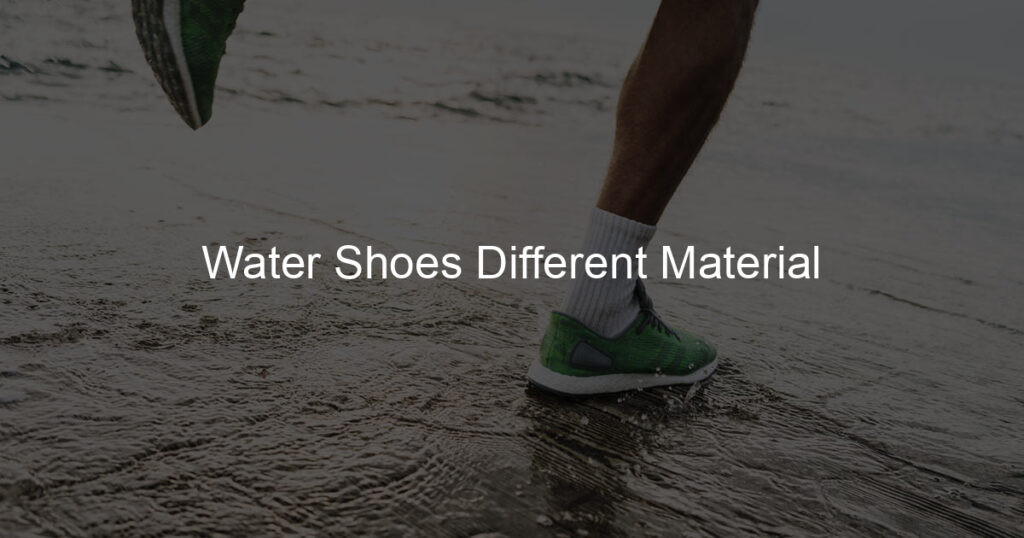We all have our different reasons for loving water shoes. Some of us love the way they protect our feet from hot sand or sharp rocks.
Others of us simply love the way they look – sleek and modern. But what we can all agree on is that different materials have different benefits.
So, let’s look closer at the three most popular materials used in water shoes today: neoprene, mesh, and rubber.
What are the different names for water shoes?
Water shoes are an everyday, functional necessity for activities involving water or wet surfaces such as beach sports, fishing, rafting, surfing, and more.
While you may call them water shoes, they have various other names like aqua socks, aqua shoes, swim shoes, and dive shoes among others! Depending on the purpose of the activity, the look and design of these varieties may significantly change.
A pair intended for deep sea diving or rock climbing would be formulated with a much sturdier material than those designed to protect against rocky beaches.
The design is often based on where it will be worn, how long it will stay underwater, what kind of terrain, and more. So next time you want to jump in the pool or go wading in a stream you can feel confident that there’s likely a specific type of water shoe for all your aquatic needs!
What material are water shoes?
Gone are the days of boring or uninspired footwear made for the water. Water shoes have become increasingly fashionable, with a variety of materials being used to create stylish yet rugged outdoor shoe styles.
Manufacturers such as Vibram and Crocs use synthetic compounds to make lightweight and durable shoes that provide maximum grip in wet conditions.
The upper part of the shoe is often made with a breathable fabric material that is quick-drying and resistant to wear.
The sole is constructed with lugs or ridges, providing superior traction on wet surfaces while also allowing water to drain away quickly. If you’re looking for a great way to add some style to your beach wardrobe, then you should check out the latest selection of water shoes available today!
What is the best material for water shoes?
When shopping for water shoes, the most crucial factor to consider is the material. After all, you want them to be lightweight, comfortable, and quick-drying so you can make the most of your time on the beach or in the pool!
Neoprene is an excellent option because it’s soft, flexible, and resistant to chlorine damage.
It’s also great at retaining heat which ensures a comfy fit. Synthetic rubber is another noteworthy option as it offers superior traction when wet. Plus, it’s antimicrobial treated, preventing bacteria from growing on the shoe so they last longer.
Ultimately, whichever material you decide to go with, make sure it fits right and doesn’t pinch or rub against your feet. That way, you’ll be all set for a fun-filled day’s adventure!
Are water shoes made for swimming?
Water shoes are an essential item for those who want to make the most of their time in the water. Whether you’re going to the beach, hiking along a stream, or enjoying your favorite water activity, wearing water shoes can provide more protection and stability.
It’s important to note, though, that although they are called “water shoes” they may not necessarily be made for swimming–as they aren’t designed to be submerged in water for long periods.
Often built with mesh fabric and lightweight materials, they are breathable and comfortable but lack the support needed while swimming.
If you’re planning some splashing around in the pool or ocean activities such as surfing, snorkeling, or diving then you’ll certainly need waterproof swimming shoes!
Are water shoes stretchy?
Water shoes are often thought of as being stretchy and form-fitting, and in many cases, this is true. They are typically made from a lightweight material that has some give for comfort.
However, some water shoes might not be stretchy at all! Materials such as rubber and neoprene can hold their shape without being overly flexible.
It is always best to try on water shoes before purchasing them to make sure they fit properly. This way you can be sure you have the right style of shoe with all the features that meet your needs and expectations!
Conclusion: Water Shoes Different Material
As you can see, water shoes are an essential item to have while being active in the water. They provide the necessary control, comfort, and stability that regular shoes cannot deliver.
While there are some downsides to wearing them, such as reduced breathability, their higher cost, and potentially irritating materials, the benefits of having water shoes far outweigh those drawbacks.
Whether you choose to invest in neoprene, leather or mesh-based water shoes is entirely up to you – just make sure they fit correctly and ensure your feet don’t get blisters. Water shoes can guarantee you a safe yet enjoyable experience in the water. So don’t forget them on your next swim!









